


 |
June 19-25, 1999: My Sister Judy Visits Dallas |
 |
May 18, 1999: A Visit to Jack Fontaine in MA |
 |
Return to the Index for 1999 |
This month, I had some work to do at a company outside Miami, so I flew down to Fort Lauderdale (actually more convenient to the northwest Miami location of the client) on a Sunday night.
|
On that Friday, Ron and Lowery, whom I hadn't seen since they left Dallas and moved to Brandon, Florida, two months ago, came over to Fort Lauderdale to spend the day with me. That evening, we drove together back to Brandon where I stayed with them for the weekend, returning to Dallas on Sunday night from Tampa.
On Friday, in addition to taking Lowery and Ron over to the beach (see the picture at left), the three of us made an excursion down to Vizcaya- an old mansion south of Miami. There, we toured the house and grounds before heading back to Fort Lauderdale.
A Tour of Vizcaya
|
I had never been to Vizcaya before, but Lowery had heard of it, so we looked up how to get down there, which was actually quite easy. We just took I-95 south from Fort Lauderdale, a few miles past the point where the Interstate ends and becomes US 1. The estate is about two miles east of US 1, on the shore of Biscayne Bay just south of downtown Miami.
The area south of downtown Miami is extremely upscale- only slightly less so that the islands in Biscayne Bay. There is a lot of old money on Star Island and Fisher Island, and also in the area around Vizcaya.
We parked in the almost empty lot (this being a weekday) and headed over to the ticket booth at the top of the drive leading to the house.
A Bit of History
When he began building his winter home, Deering engaged the assistance of Paul Chalfin, a young New York painter, to supervise the entire project. Deering and Chalfin traveled throughout Europe surveying residential architecture for ideas and obtaining components such as doors, wall panels, mantels and ceilings that would be incorporated into the proposed home. Also working on the project were architect F. Burrall Hoffman and Colombian landscape architect Diego Suarez. The house was intended to appear as an Italian estate that had stood for 400 years and had been occupied and renovated by several generations of a family. It has 34 decorated rooms with 15th through 19th century antique furnishings and art objects. The house appears to be only two stories high but between the main public rooms and the bedrooms, there is an intervening level with 12 rooms for servants and service.
The expansive gardens combine elements of Renaissance Italian and French designs. Suarez and Chalfin worked for seven years, perfecting the design of the gardens as one vast outdoor room with the elements serving as complementary parts of an integrated area. Key features include the many fountains, a central pool surrounding an elevated island, the elevated Mound with its small house, or “Casino,” statuary, and several themed gardens.
|
Over the years the effects of South Florida’s humid climate and salt air have taken their toll on Vizcaya, necessitating continuous restoration. Although the house’s design allowed the free flow of breezes through the open courtyard, the need to preserve the building and contents required the installation of a climate and humidity control system, including enclosing the open courtyard in glass. Today we can only imagine how Vizcaya felt as an open-air house, with the sounds of birds and the bay, the sudden rain showers, and the fragrance of flowers.
Today, we'll be touring the main house, walking through the formal gardens and ending with the quay that was built along Biscayne Bay. We'll return to the entrance via the north siwalking de of the house.
Entry to Vizcaya
|
Touring the Main House
The tour began in the entrance loggia. The entrance loggia was originally open to the outdoors, its shaded vaults and cool marble surfaces offering visitors a transition from the subtropical heat to the shaded rooms within. The main entrance to the house is at the left in this picture. Just behind the reception desk is a colonnade and beyond that the central atrium. Although it is enclosed now, the atrium used to be open to the sky and in all four directions through wide breezeways.
|
On the second floor, there were rooms all around the sides of the square. The interior was still open, however, and there were balcony hallways overlooking the courtyard on three of the four sides of the square as well as some individual balconies for individual rooms on the outside of the house. There were main stairways in two corners of the house and smaller service stairways in the other two.
Generally, our tour went clockwise around the first floor ending in the southwest part of the floor, and then went up a small service stairway to the second floor, where it continued around in the same direction before descending another stairway back down to the first floor. We ended in the courtyard where the tour guide answered questions.
As I said, I wasn't able to take but a couple of pictures of my own on our tour, so in this narrative I'll just use some of Vizcaya's official pictures to give you an idea of what the rooms were like. I did get one nice inside picture to show you the intricate decorative detail of all the rooms throughout the house. I can only imagine that the woodwork and painting took a great deal of time and effort, but the results were quite beautiful. That picture is below, left.
|
Leaving the Reception Room, we walked east across a hallway to what appeared to be a general living room. The room was wonderfully furnished. It included a small pipe organ in one corner of the room and a huge fireplace at the other end of the salon.
There were two other very pretty rooms here in this part of the house that you should see, and I have stock pictures for them:
|
|
|
Turning west on the tour, we crossed the Tea Room. This beautiful, bright and airy room overlooks the formal gardens to the south. It features stained glass doors that both filter the harsh sunlight and cast colorful reflections on the inlaid marble floors. I thought that the Tea Room was one of the nicest rooms we saw, even though it contained almost no furniture. (I presume that in Deering's time there were either tables always set up or ones that could be brought in as needed. There was a very ornate courtyard entrance from the Tea Room. Just off this room, behind the large fireplace, was a room where Deering's various sets of china and silver were kept. There was also, as you might expect, a large collection of different tea services that he had acquired.
The main kitchen and service areas for the house were located in the southwest corner, and our tour continued through the china storage off the Tea Room into that area. Here, we took a spiral staircase to the second floor.
On the second floor were James Deering's suite, various guest rooms, a small kitchen to serve the floor and a breakfast room. I can't recall the order of the rooms, and I couldn't get my own pictures, so here are some representative rooms (pictures taken from the Vizcaya website):
|
|
|
|
Deering had a particularly elegant suite overlooking Biscayne Bay. The Breakfast Room's mixture of Neapolitan seascapes, Chinese ceramics and European-made "Chinoiserie" connotes the exchange of artistic goods and styles between East and West in the Age of Exploration.
|
Before we left the second floor to exit the house, I was able to get a nice picture of the central atrium. You can see that it is now roofed, although when Deering built the house it wasn't.
The Formal Gardens
|
As soon as you come around the house to the gardens, you are on a broad flagstone patio, and from there you can take the broad steps down into the garden, or walk around to the east side of the house facing Biscayne Bay. We walked down into the garden past a nice fountain at the base of the steps, to an area surrounded by curved walls with archways, which led to small enclosed gardens.
On the north side of the garden there was a walkway, which passed a pool enclosed by a circular stone wall which was topped with columns and sculptures. Throughout the garden there were numerous Greek Revival sculptures.
|
The Mound is an elevated area, perhaps twenty feet above the level of the main garden. At the front of The Mound, facing the mansion, there is a stairway on either side that leads up halfway, circles a short distance around the front of The Mound, and then continues to the top.
From here, we returned to the main house to go to the east of it to the Quay and have a look at the views out to Biscayne Bay.
|
Standing on the quay we were right in front of the mansion, and between us and the Bay was the Stone Barge. On a practical level, Vizcaya's Stone Barge acts as a breakwater against tidal surges. On an artistic level, the limestone sculpture extends the art and architecture of the main house and gardens beyond the shoreline and into the waters of Biscayne Bay. It reminded me of Cleopatra's barge from the movies, except that all the figures aboard it were of limestone. With the striped poles, though, the scene was even more evocative of Venice.
Click on the thumbnail images below for some other views of the mansion and the Quay:
 |
After we spent some time on the Quay in the bright sunshine, we decided to head back to Fort Lauderdale so that Lowery and Ron could head back to Brandon where I will meet them tomorrow.
Visiting Lowery and Ron in Brandon
|
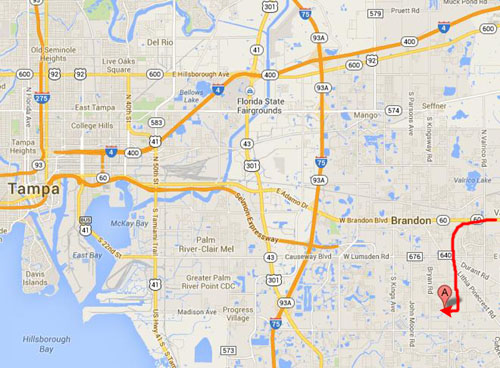 |
Lowery and Ron live in a very nice, secluded neighborhood of Brandon. Their particular street, Belle Timbre, is a cul-de-sac, and the nice thing was that behind their house was open farmland that was also floodplain, and so would never be developed. Looking out from their lanai, you couldn't see another structure- just grassland, trees and cows grazing in the distance.
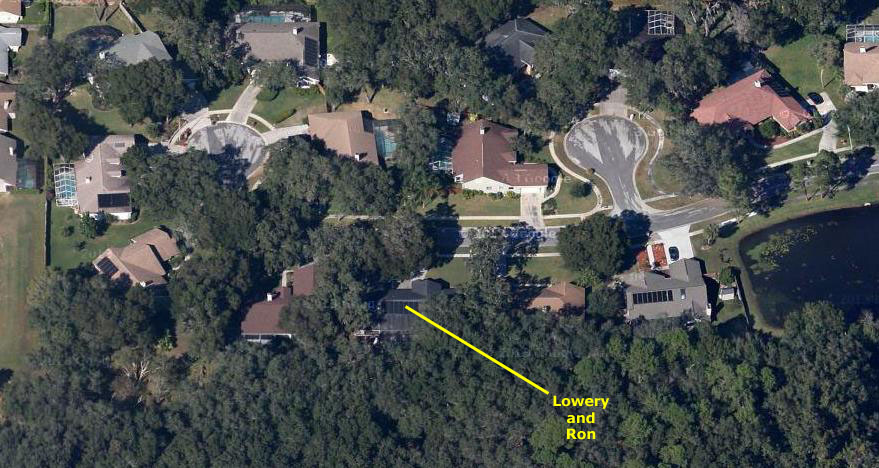 |
For the couple of days I was there, we stuck mostly around their house, and went out to eat a couple of times. I told them I would like to come back with Fred in tow, and then we'd like to see where Ron worked in downtown Tampa. For this visit, though, I did my normal "documenting thing" and took lots of pictures of their house- mostly so I could show them to Fred. So I just want to include those pictures here. From the street, here is a view of Lowery and Ron's house. And from the street, you can walk across the curving drive (the garage is offset to your right, facing east- not facing north and the street) to the front door. Coming in through the door puts you in a kind of foyer. From this entry space, you can go forward into the kitchen/family room, right to the family room and guest rooms or left towards the master. I don't have a diagram of the house, but when you enter, if you turn left you will pass a small front room that is used as an office and you will also pass the dining room (which has an entry directly to the kitchen). There is another view of the dining room here. Further down that hall is Lowery and Ron's master bedroom. It has a very large spa bathroom which, oddly enough, has a window to the front of the house- right by the tub. I remember Lowery saying he wasn't fond of the front-facing bathroom window, but their window treatments keep it pretty private. Another nice feature of their master bedroom is that it has a large window to the back of the house (and the pastoral vista behind it) as well as an entrance to the screened lanai.
|
Click on the thumbnail images below to see these three rooms:
 |
None of these three rooms have their own bath- they share one at the end of the hall nearest the lanai; that bathroom is also used as the bathroom for people using the pool, and there is an entrance from it directly to the lanai. You can see a picture of this bathroom here.
The center area of the house is taken up by the family room/kitchen area and the lanai. The family room and kitchen together form kind of a "great room," with the counter that has the sink situated so that someone working there can see everyone else in the room. A nice idea. You can get a good idea of what this area is like by looking at the two pictures below:
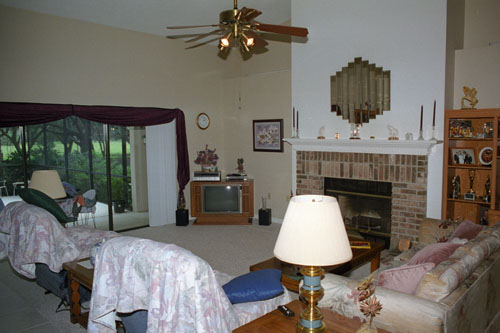 The Family Room |
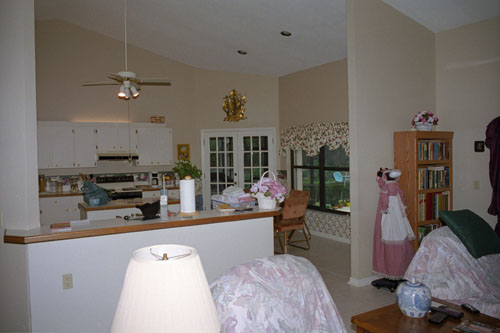 The Kitchen |
You can see another view looking from the side of the kitchen near the dining room back towards the family room here.
Personally, I think that the nicest feature of the house is the screened lanai and pool area. The entire outdoor space is covered with a fine screen that let the breeze in but is fine enough to keep just about every kind of flying insect out. The screen is also fine enough so as to act as a sunshade; even when the sun is overhead, the light inside the lanai is muted. The pool is very nice, and it has its own spa. The two pictures below should give you an excellent idea of what this outdoor living space is like:
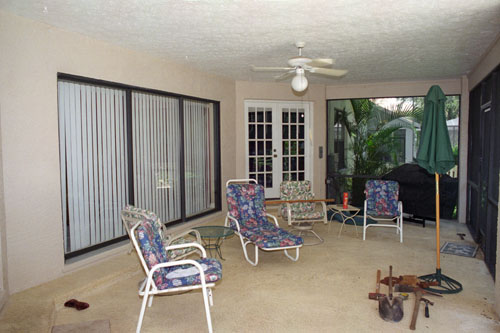 The Lanai Sitting Area |
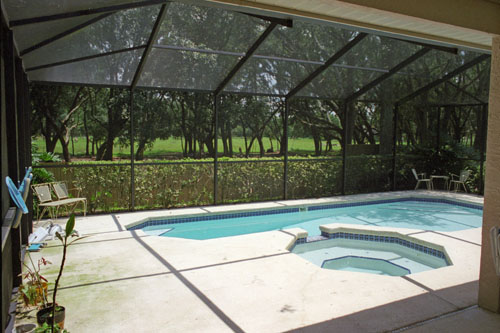 The Pool |
Lowery still likes to do a bit of gardening when the weather is nice, and there is a small backyard, reachable through the lanai screen door.
I spent a nice weekend with Lowery and Ron, but Sunday night it was time for me to head home. So I bid them farewell (promising to bring Fred back the next time I came) and took my rental car to the Tampa airport for a flight home.
You can use the links below to continue to another photo album page.
 |
June 19-25, 1999: My Sister Judy Visits Dallas |
 |
May 18, 1999: A Visit to Jack Fontaine in MA |
 |
Return to the Index for 1999 |